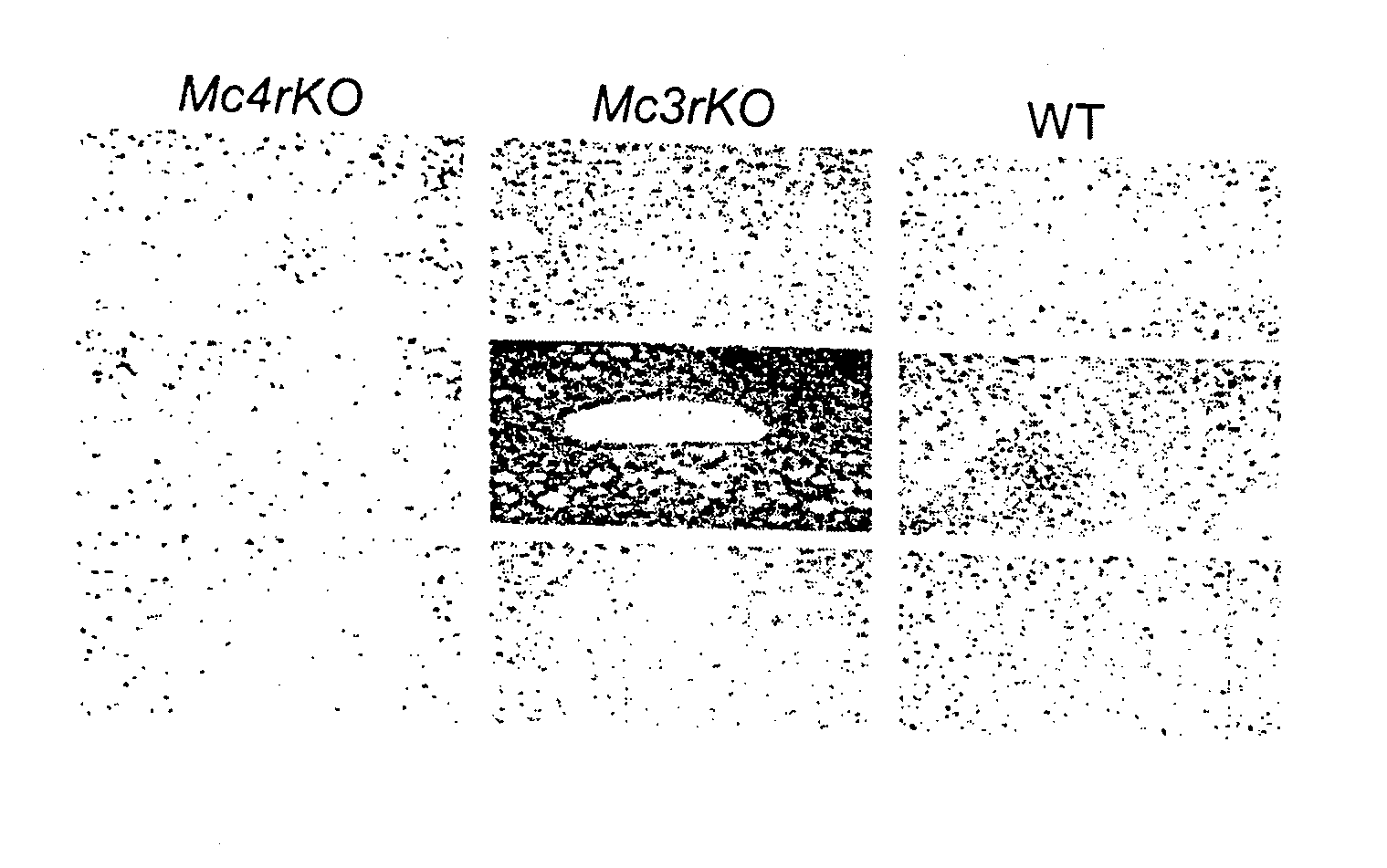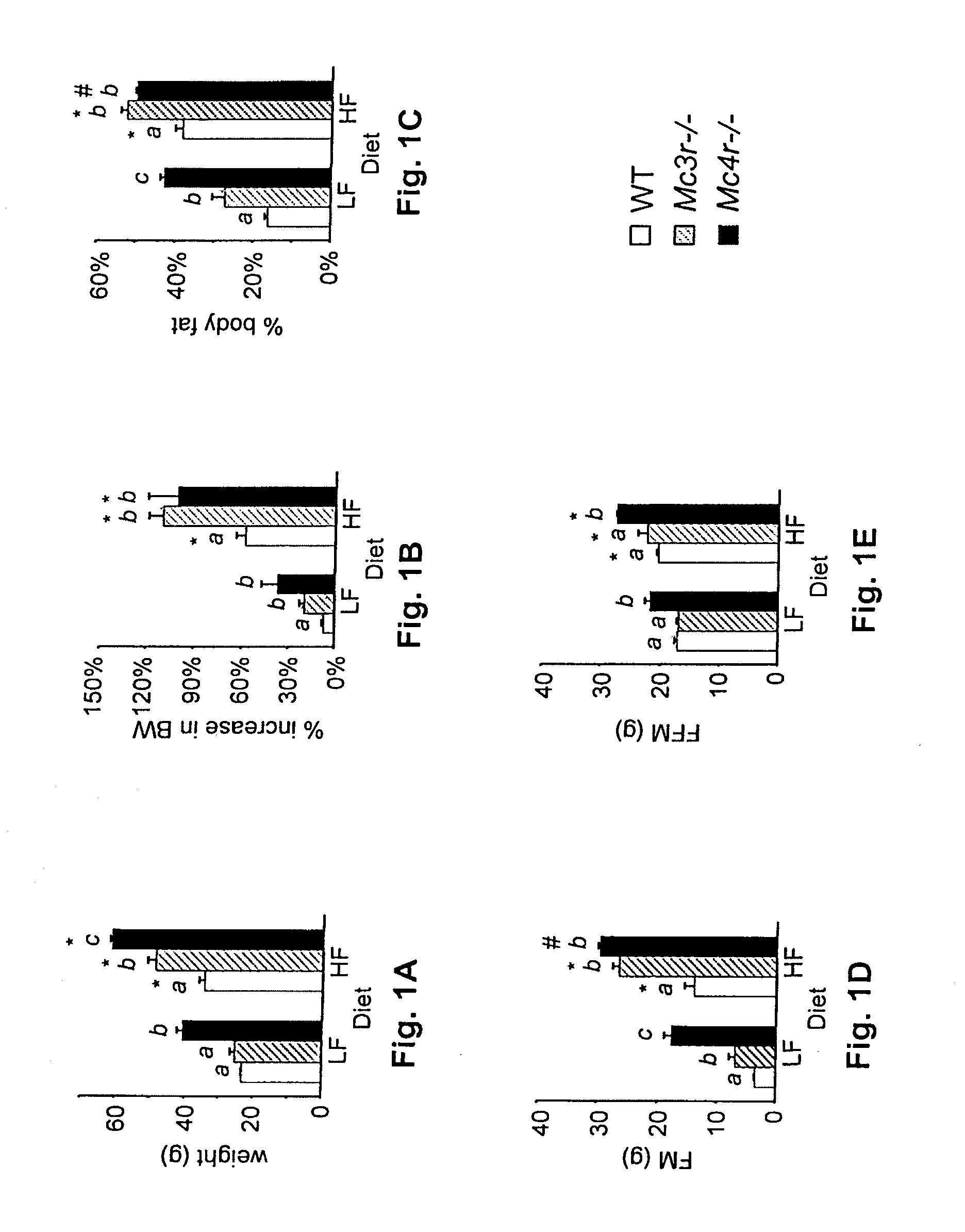Novel peptide involved in energy homeostasis
a peptide and energy homeostasis technology, applied in the field of new genes, can solve the problems of reducing the metabolic rate to compensate, and achieve the effect of a robust increase in the phosphorylation of erk1
- Summary
- Abstract
- Description
- Claims
- Application Information
AI Technical Summary
Benefits of technology
Problems solved by technology
Method used
Image
Examples
example 1
Discovery of Enho1 Protein and Its Function
[0063]Microarrays analyzing hepatic gene expression in lean and obese Mc3rKO were performed using arrays printed from libraries of 16,463-18,400 70-mer oligonucleotides (Mouse Array-Ready Oligo Set Version 2.0, Qiagen Operon, Alameda, Calif.) (34-36). The microarray data indicated increased expression of genes involved in lipid metabolism (apoliproteins) and oxidative stress secondary to obesity. Interestingly, the expression of only three genes was reduced in liver of Mc3rKO irrespective of age, gender, and adiposity. Two of the genes encoded proteins with known function: neuraminidase 3 (neu3), encoding an enzyme that cleaves sialic acid from glycoproteins and glycolipids, and solute carrier family 21 (slc21a1) which encodes an organic anion transporter. The third gene (AK009710) was novel and had no assigned function in the databases.
[0064]Quantitative RealTime PCR confirmed the microarray data showing a tendency for a modest reduction i...
example 2
Sequence and Bioinformatics Analysis
[0069]AK009710 is a mouse tongue cDNA clone 1247 by in length and belongs to the Unigene cluster Mm.34074, 2310040A07Rik: RIKEN cDNA 2310040A07 gene. It hypothetically could encode a 534 amino acid protein immediately from the 5′ end of the sequence. Given that this putative protein did not start with a methionine residue, it was listed as a truncated product. BLAST analysis of AK009710 for homologous EST or cDNA sequences on the NCBI database revealed a significant match with NM198573, a human transcript discovered by a large-scale Secreted Protein Discovery Initiative encoding a hypothetical protein of 87 aa (UNQ470 / GAAI470) (37). The match with human sequence—NM—198573 was 85% identity across 392 nucleotides, p=5e−83. The human sequence encoded an 87 amino acid protein in one exon. Translation of AK009710 in six frames revealed an open reading frame encoding a 76 amino acid protein (SEQ ID NO:2). An alignment between this putative mouse protein...
example 3
Tissue Distribution of Enho1
[0073]In order to examine the tissue distribution of AK009710 mRNA a Northern blot was performed using the 210 nt sequence containing the 76 amino acid protein ENHO1 and a human Multiple Tissue Northern blot (BD Biosciences, Palo Alto, Calif.). As can be seen in FIG. 6A, a single band of ˜1.35 kb was detected in humans in brain and liver samples only, with highest levels detected in the liver. However, as seen in FIG. 6B, Enho1 was found in mice in the liver, brain, and muscle.
PUM
| Property | Measurement | Unit |
|---|---|---|
| body weight | aaaaa | aaaaa |
| weight | aaaaa | aaaaa |
| weight | aaaaa | aaaaa |
Abstract
Description
Claims
Application Information
 Login to View More
Login to View More - R&D
- Intellectual Property
- Life Sciences
- Materials
- Tech Scout
- Unparalleled Data Quality
- Higher Quality Content
- 60% Fewer Hallucinations
Browse by: Latest US Patents, China's latest patents, Technical Efficacy Thesaurus, Application Domain, Technology Topic, Popular Technical Reports.
© 2025 PatSnap. All rights reserved.Legal|Privacy policy|Modern Slavery Act Transparency Statement|Sitemap|About US| Contact US: help@patsnap.com



